-
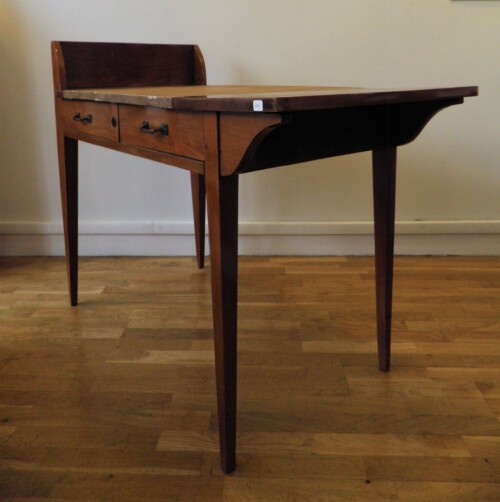
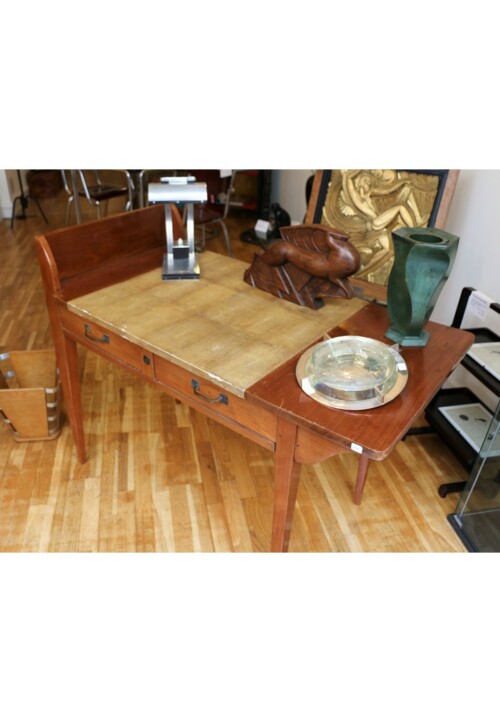 Eugène PRINTZ (1889-1948) Elégant bureau, dessiné par Printz pour la fameuse Cité Universitaire Internationale de Paris, de forme asymétrique, en acajou verni, ouvrant en façade par deux tiroirs. Les poignées sont en métal patiné et les plateau est recouvert d'un revêtement imitant le galuchat. Le bureau est dans son état original, et n'a jamais été restauré. La clef des tiroirs est manquante. Dans notre galerie se trouve aussi une étagère Printz destinée à la même résidence. 1930's H : 91 cm ; L : 113 cm ; P : 55 cm Pour plus d'informations sur le créateur, cliquer sur le nom : Eugène PRINTZ
Eugène PRINTZ (1889-1948) Elégant bureau, dessiné par Printz pour la fameuse Cité Universitaire Internationale de Paris, de forme asymétrique, en acajou verni, ouvrant en façade par deux tiroirs. Les poignées sont en métal patiné et les plateau est recouvert d'un revêtement imitant le galuchat. Le bureau est dans son état original, et n'a jamais été restauré. La clef des tiroirs est manquante. Dans notre galerie se trouve aussi une étagère Printz destinée à la même résidence. 1930's H : 91 cm ; L : 113 cm ; P : 55 cm Pour plus d'informations sur le créateur, cliquer sur le nom : Eugène PRINTZ
Art Déco wooden desk, by Eugène Printz. This asymmetric desk was designed by Eugène Printz (1889-1948) for the famous Cité Universitaire Internationale de Paris (a unique place where multiple residences - one per country - for international students were developped in the 1930's). It is made of varnished mahogany, has 2 drawers with patinated metal handles and is partly covered with canvas with a shagreen pattern. It is in its original condition and has not been restored. The drawer key is missing. The gallery has also in stock a matching book shelf which was also designed by Printz for the same residence. Dimensions : H : 35.83 in. ; W : 44.49 in. ; D : 21.65 in. H : 91 cm ; W : 113 cm ; D : 55 cm For more information : Eugène PRINTZ -
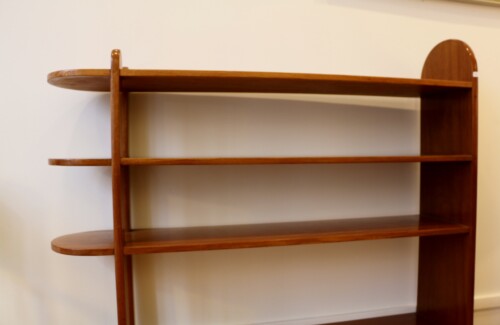
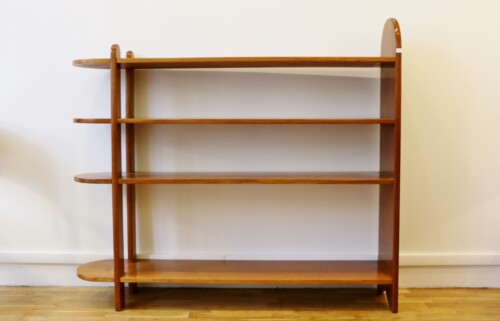 Eugène PRINTZ (1889-1948) Étagère bibliothèque en acajou de 1932, pour la Cité Universitaire de Paris destinée aux chambres d'étudiants de la Maison des Provinces de France. Quatre étagères rectangulaires se terminant en demi-lune H : 119,5 cm ; L : 135 cm ; P : 30 cm Pour plus d'informations sur le créateur, cliquer sur le nom : Eugène PRINTZ
Eugène PRINTZ (1889-1948) Étagère bibliothèque en acajou de 1932, pour la Cité Universitaire de Paris destinée aux chambres d'étudiants de la Maison des Provinces de France. Quatre étagères rectangulaires se terminant en demi-lune H : 119,5 cm ; L : 135 cm ; P : 30 cm Pour plus d'informations sur le créateur, cliquer sur le nom : Eugène PRINTZ
An Art Deco Mahogany Shelf or Bookcase by Eugène Printz, 1932.Light mahogany shelves bookcase with four shelves.
One side of each shelf has an arc of a circle shape. 1932 iconic model from Eugène Printz.
Dimensions :For more information : Eugène PRINTZH : 47.05 in. ; W : 53.15 in. ; D : 11.81 in.H : 119.5 cm ; W : 135 cm ; D : 30 cm -
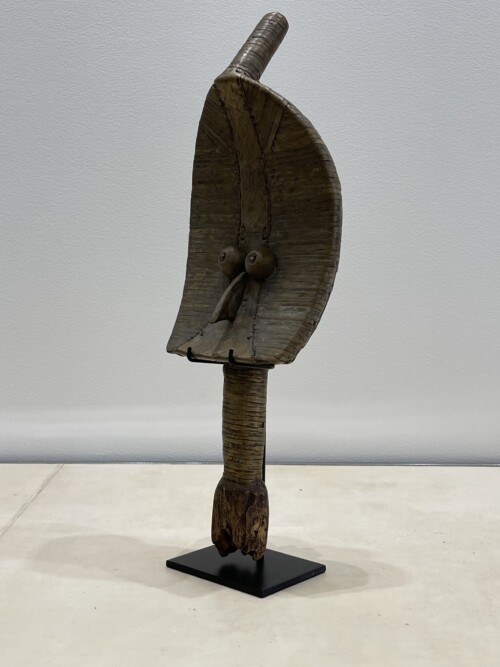
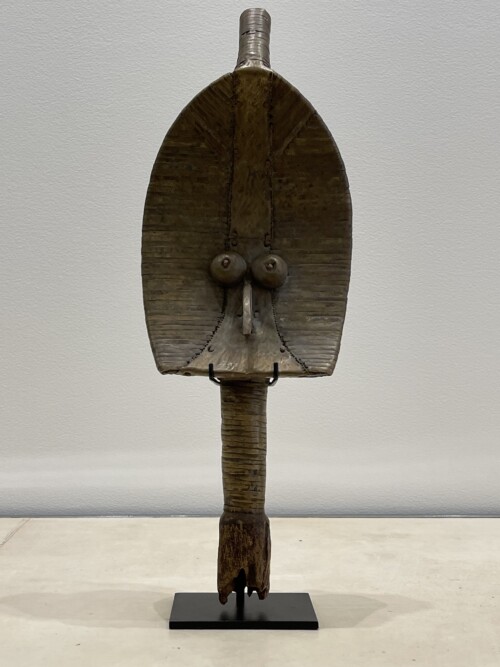 Cet exceptionnel reliquaire Kota provient de la tribu Mahogwe qui vit sur le fleuve Ogooué au Gabon. Les Mahogwe font partie de l'ethnie Kota basée au Nord-Est du Gabon. Cette sculpture est exceptionnelle car elle a été collectée in situ par un administrateur colonial du nom de Fernand Oliveda qui fut un administrateur colonial de haut rang basé entre 1888 et 1930 à Madagascar, au Sénégal et au Congo. En 1925, il était chef du secrétariat du gouverneur général du Moyen-Congo (alors nom du Gabon). Il est très rare de pouvoir avoir une traçabilité claire pour un tel objet, sa collection d'art africain étant restée dans la famille depuis ! Il est composé de bois, de laiton et de cuivre. De fines lamelles de laiton/cuivre enveloppent le noyau bois. Au dos une fine plaque de laiton/cuivre décorée recouvre le bois. Un support en fer moderne sur mesure est fourni pour afficher la sculpture. This exceptional Kota reliquary comes from the Mahogwe tribe who lives on the river Ogooué in Gabon. The Mahogwe are part of the Kota ethnic group based in the North-East of Gabon. This sculpture is exceptional because it was collected in situ by a colonial administrator named Fernand Oliveda who was a high ranking colonial administrator based between 1888 and 1930 in Madagascar, Senegal and Congo. In 1925 he was Chief of Secretariat for the Middle Congo Governor General (the then name for Gabon). It is very rare to be able to have clear traceability for such an item as his African art collection was kept in the family since then! It is made of wood, brass and copper.. Thin strips of brass/copper are envelopping the wood core. On the back a thin decorated plate of brass/copper covers the wood. A bespoke modern iron stand is provided to desplay the sculpture.
Cet exceptionnel reliquaire Kota provient de la tribu Mahogwe qui vit sur le fleuve Ogooué au Gabon. Les Mahogwe font partie de l'ethnie Kota basée au Nord-Est du Gabon. Cette sculpture est exceptionnelle car elle a été collectée in situ par un administrateur colonial du nom de Fernand Oliveda qui fut un administrateur colonial de haut rang basé entre 1888 et 1930 à Madagascar, au Sénégal et au Congo. En 1925, il était chef du secrétariat du gouverneur général du Moyen-Congo (alors nom du Gabon). Il est très rare de pouvoir avoir une traçabilité claire pour un tel objet, sa collection d'art africain étant restée dans la famille depuis ! Il est composé de bois, de laiton et de cuivre. De fines lamelles de laiton/cuivre enveloppent le noyau bois. Au dos une fine plaque de laiton/cuivre décorée recouvre le bois. Un support en fer moderne sur mesure est fourni pour afficher la sculpture. This exceptional Kota reliquary comes from the Mahogwe tribe who lives on the river Ogooué in Gabon. The Mahogwe are part of the Kota ethnic group based in the North-East of Gabon. This sculpture is exceptional because it was collected in situ by a colonial administrator named Fernand Oliveda who was a high ranking colonial administrator based between 1888 and 1930 in Madagascar, Senegal and Congo. In 1925 he was Chief of Secretariat for the Middle Congo Governor General (the then name for Gabon). It is very rare to be able to have clear traceability for such an item as his African art collection was kept in the family since then! It is made of wood, brass and copper.. Thin strips of brass/copper are envelopping the wood core. On the back a thin decorated plate of brass/copper covers the wood. A bespoke modern iron stand is provided to desplay the sculpture. -
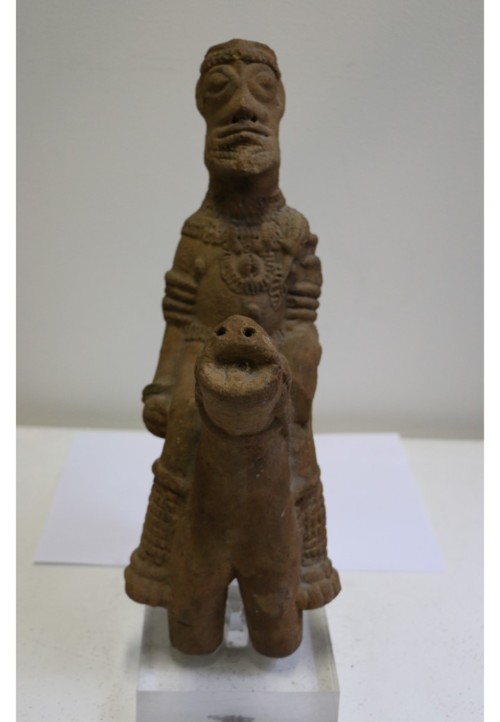
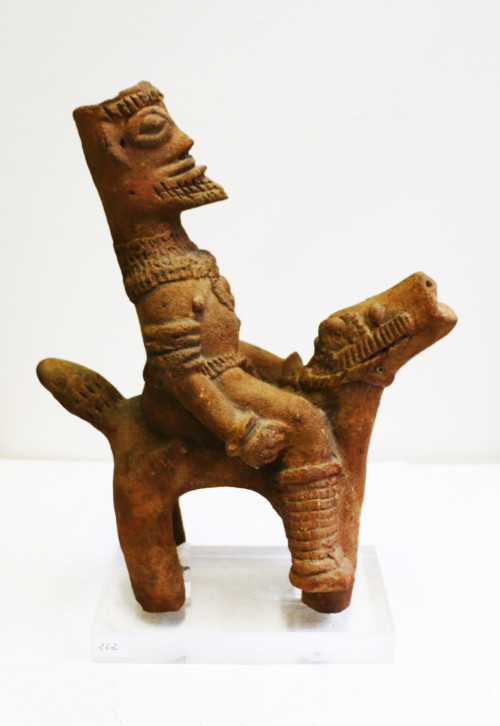 Figure équestre Koma-Bulsa – Ghana Terre cuite, XIV-XV siècle (datation par test de thermoluminescence) Sculpture naturaliste présentant certains motifs artistiques typiques des anciennes traditions culturelles Koma-Bulsa, notamment la coiffure cocave avec ornements frontaux tressés, le collier chiik en demi-lune semblable à celui que portent les Bulsa aujourd’hui, le poignard inséré dans une lanière ornementale portée à l’l’épaule gauche. H : 33,5 cm ; L : 26 cm ; P : 13 cm Test de thermoluminescence Interexpert 388317 du 18 mars 1988
Figure équestre Koma-Bulsa – Ghana Terre cuite, XIV-XV siècle (datation par test de thermoluminescence) Sculpture naturaliste présentant certains motifs artistiques typiques des anciennes traditions culturelles Koma-Bulsa, notamment la coiffure cocave avec ornements frontaux tressés, le collier chiik en demi-lune semblable à celui que portent les Bulsa aujourd’hui, le poignard inséré dans une lanière ornementale portée à l’l’épaule gauche. H : 33,5 cm ; L : 26 cm ; P : 13 cm Test de thermoluminescence Interexpert 388317 du 18 mars 1988
Exceptional antique African Tribal Art terracotta sculpture representing a rider on his horse. It dates back from the 14th -15th century AD and its dating has been confirmed by a thermoluminescence test (Interexpert certificate 388317, 18 March 1988) - scan attached with the photos. It belongs to the Koma-Bulsa culture located in present Ghana. This is a naturalist sculpture with traditional Koma-Bulsa patterns as the concave shape hairstyle, the half-moon chiik necklace similar to the ones worn by Bulsa people today, the knife laced on the upper arm. It is exceptional to find a confirmed antique African terracotta in such a well-preserved state. (TL Test) -
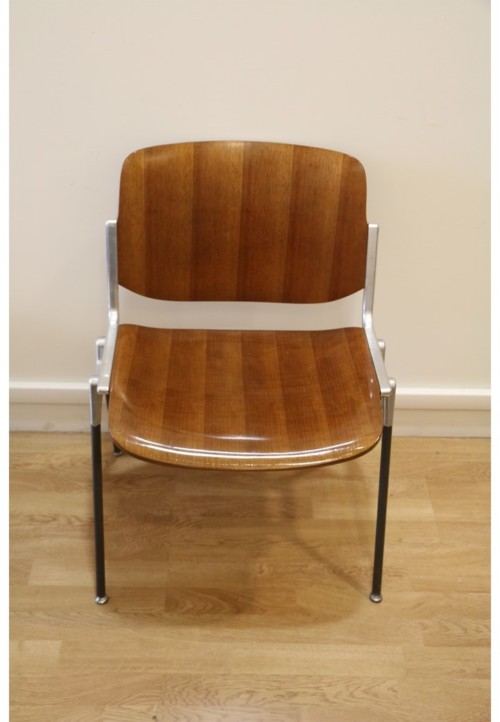
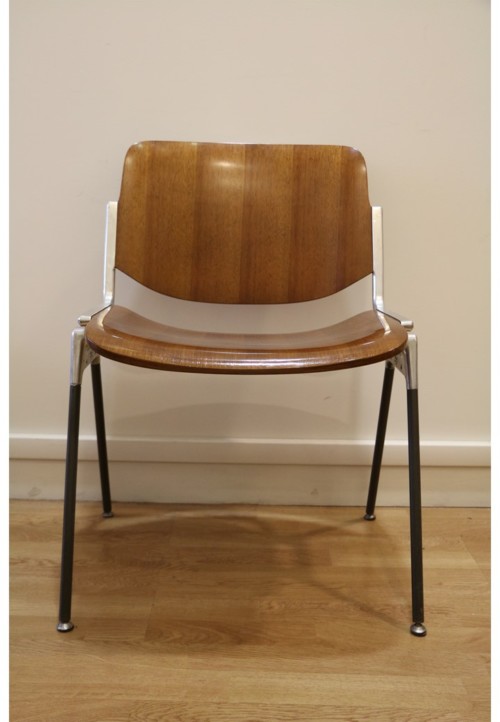 Giancarlo PIRETTI (1940-…) Edition Castelli. Suite de 6 chaises, modèle 106 dessiné en 1967. Assise et dossier en contreplaqué moulé, piètement quadripode tubulaire, gainé avec sabots. Plus édité. Couleur miel foncé H : 77 cm ; H d'assise : 48 cm ; L : 56 cm ; P : 48 cm Pour plus d’informations sur le créateur, cliquer sur le nom : Giancarlo PIRETTI
Giancarlo PIRETTI (1940-…) Edition Castelli. Suite de 6 chaises, modèle 106 dessiné en 1967. Assise et dossier en contreplaqué moulé, piètement quadripode tubulaire, gainé avec sabots. Plus édité. Couleur miel foncé H : 77 cm ; H d'assise : 48 cm ; L : 56 cm ; P : 48 cm Pour plus d’informations sur le créateur, cliquer sur le nom : Giancarlo PIRETTI
Set of Six Mid-Century Modern Chairs by Giancarlo Piretti, Italy, 1970s. Set of six chairs by Giancarlo Piretti, Model Nr 106 designed in 1967, Italy, Castelli edition. This model is no longer manufactured. Chair back and chair seat made of thermoformed/molded plywood. Veneer has been restored, Very nice light honey color. Legs and frame made of steel and aluminium. These chairs are very comfortable and can be stacked. Another set of six identical chairs is available with a slightly lighter veneer. Measures: H 77 cm; Seating H 48 cm; L 56 cm; P 48 cm. For more informations : Giancarlo PIRETTI -
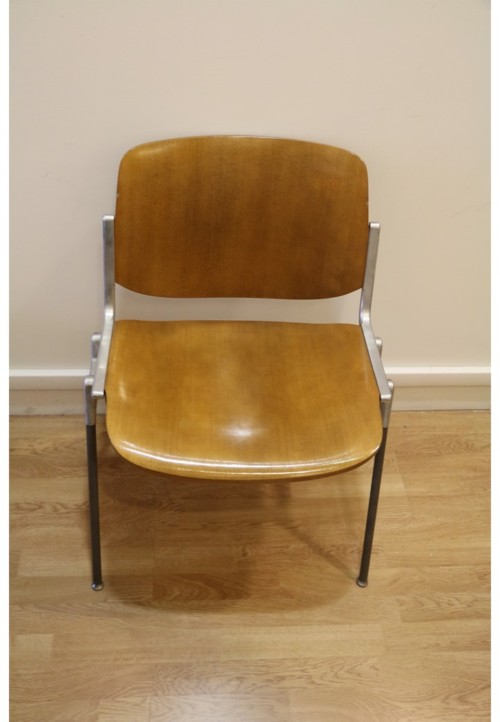
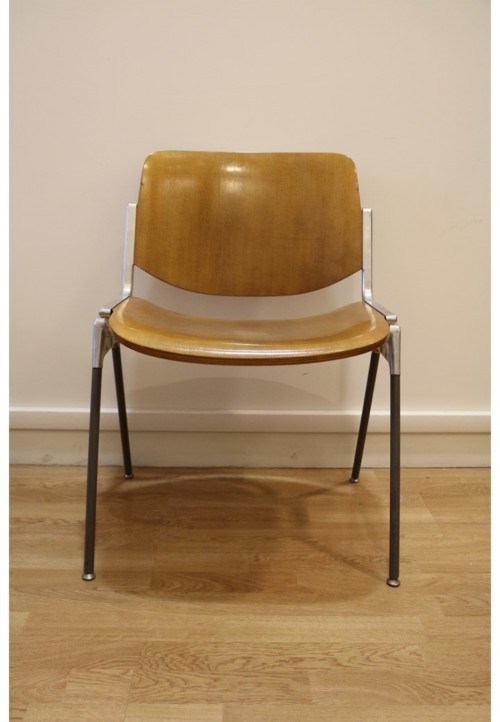 Giancarlo PIRETTI (1940-…) Edition Castelli. Suite de 6 chaises, modèle 106 dessiné en 1967. Assise et dossier en contreplaqué moulé, piètement quadripode tubulaire, gainé avec sabots. Plus édité. Couleur miel clair H : 77 cm ; H d'assise : 48 cm ; L : 56 cm ; P : 48 cm Pour plus d’informations sur le créateur, cliquer sur le nom : Giancarlo PIRETTI
Giancarlo PIRETTI (1940-…) Edition Castelli. Suite de 6 chaises, modèle 106 dessiné en 1967. Assise et dossier en contreplaqué moulé, piètement quadripode tubulaire, gainé avec sabots. Plus édité. Couleur miel clair H : 77 cm ; H d'assise : 48 cm ; L : 56 cm ; P : 48 cm Pour plus d’informations sur le créateur, cliquer sur le nom : Giancarlo PIRETTI
Set of Six Mid-Century Modern Chairs by Giancarlo Piretti, Italy, 1970s. Set of six chairs by Giancarlo Piretti, Model Nr 106 designed in 1967, Italy, Castelli edition. This model is no longer manufactured. Chair back and chair seat made of thermoformed/molded plywood. Veneer has been restored, Very nice light honey color. Legs and frame made of steel and aluminium. These chairs are very comfortable and can be stacked. Another set of six identical chairs is available with a slightly darker veneer. Measures: H 77 cm; Seating H 48 cm; L 56 cm; P 48 cm. For more informations : Giancarlo PIRETTI -
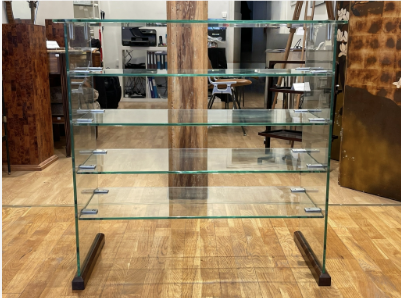
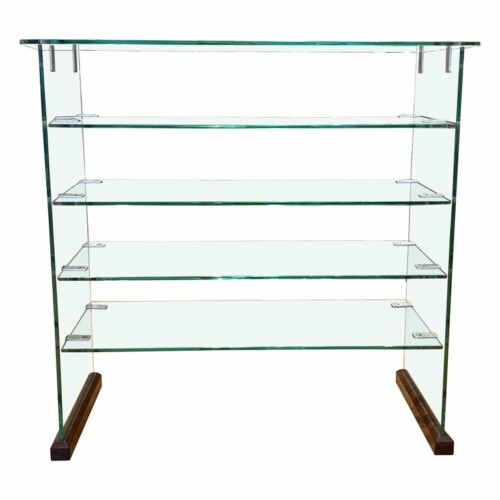 GIO PONTI, Etagère en laiton et verre, Circa 1939 Elégante étagère de laiton et de verre, comportant cinq étagères soutenues de bois maintenues par deux lames de verres aux extrémités, le tout solidement relié et fixé par des vis en laiton. Le verre est engravé « Vitrex » Réalisé à l’origine pour les bureaux de la société Ventrocoke à Milan Gio Ponti est diplômé de l’Ecole Polytechnique de Milan, et ouvre en 1921 son cabinet d’architecture. Il est nommé directeur artistique de la manufacture de porcelaine Richard-Ginori en 1923. En 1925,il remporte un grand prix à l’Exposition internationale des Arts Décoratifs de Paris. Il collabore également avec les marques Christofle à Paris et Venini à Murano. En parallèle, il crééé galement des séries de meubles Art Deco à des prix accessibles , La Rinascente, pour les grands magasins italiens un choix. S’ajoute à cela sa revue Domus fondée en 1928 dans laquelle il mettra en avant le « made in italy ». Dans les années 1930, il entame la construction des Case Tipiche, à Milan, et des bureaux pour la société Montecatini. En 1940, il se consacre au Palazzo del Bo de l’université de Padoue. Pour finir de 1950 à 1960, Gio Ponti sera surtout connu pour son architecture qu’il déployera à travers le monde Dimensions : H : 84 cm L : 88 cm P : 37 cm
GIO PONTI, Etagère en laiton et verre, Circa 1939 Elégante étagère de laiton et de verre, comportant cinq étagères soutenues de bois maintenues par deux lames de verres aux extrémités, le tout solidement relié et fixé par des vis en laiton. Le verre est engravé « Vitrex » Réalisé à l’origine pour les bureaux de la société Ventrocoke à Milan Gio Ponti est diplômé de l’Ecole Polytechnique de Milan, et ouvre en 1921 son cabinet d’architecture. Il est nommé directeur artistique de la manufacture de porcelaine Richard-Ginori en 1923. En 1925,il remporte un grand prix à l’Exposition internationale des Arts Décoratifs de Paris. Il collabore également avec les marques Christofle à Paris et Venini à Murano. En parallèle, il crééé galement des séries de meubles Art Deco à des prix accessibles , La Rinascente, pour les grands magasins italiens un choix. S’ajoute à cela sa revue Domus fondée en 1928 dans laquelle il mettra en avant le « made in italy ». Dans les années 1930, il entame la construction des Case Tipiche, à Milan, et des bureaux pour la société Montecatini. En 1940, il se consacre au Palazzo del Bo de l’université de Padoue. Pour finir de 1950 à 1960, Gio Ponti sera surtout connu pour son architecture qu’il déployera à travers le monde Dimensions : H : 84 cm L : 88 cm P : 37 cm
GIO PONTI, Brass and glass shelf, Circa 1939 Elegant brass and glass shelf, featuring five supported wooden shelves held by two glass blades at the ends, all securely connected and fixed by brass screws. The glass is engraved «Vitrex» Originally designed for the Ventrocoke offices in Milan Gio Ponti graduated from the Polytechnic of Milan, and opened his architectural practice in 1921. He was appointed artistic director of the Richard-Ginori porcelain factory in 1923. In 1925, he won a grand prize at the International Exhibition of Decorative Arts in Paris. He also collaborates with the brands Christofle in Paris and Venini in Murano. In parallel, he also created series of Art Deco furniture at affordable prices , La Rinascente, for Italian department stores a choice. In addition to this, his magazine Domus, founded in 1928, will highlight the «made in italy». In the 1930s, he began the construction of the Case Tipiche in Milan and offices for the company Montecatini. In 1940 he dedicated himself to the Palazzo del Bo of the University of Padua. To finish from 1950 to 1960, Gio Ponti will be best known for his architecture that he will deploy around the world Dimensions: H: 33.1inches W: 34.5inches D: 14.5inches -
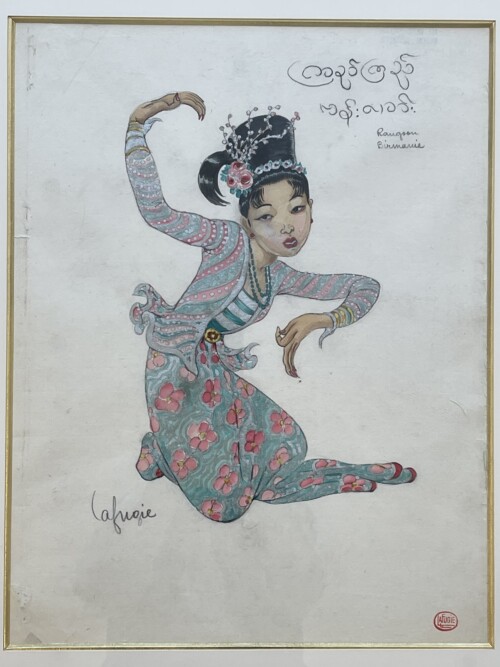
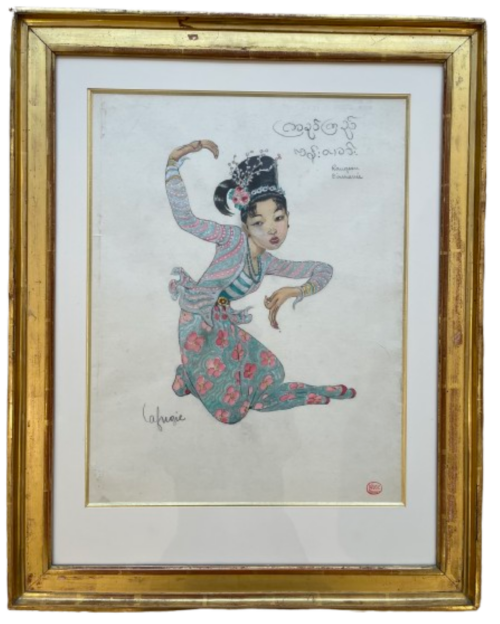 Léa LAFUGIE est une artiste peintre qui a voyagé à travers l’Asie se faisant surtout connaître pour ses portraits ainsi que ses paysages qu’elle retranscrit dans ses peintures. Elle étudie à l’École des Arts Décoratifs de Paris, puis à l’École des Beaux-Arts de Paris. Dotée d’une nature aventureuse et curieuse, c'est en 1925 que l’artiste décide de voyager en Asie, dont la Chine, l’Inde, le Japon et la péninsule indochinoise. Elle y peindra des paysages ainsi que des portraits lors de ses séjours. Cette gouache représente une danseuse birmane dépeinte lors d’une démonstration de son art avec des mouvements serpentins, renvoyant aux motifs fleuris de son costume aux couleurs douces, le tout relevé par une peinture argentée. Cette gouache est signée en haut à droite avec une inscription « Birmanie » en haut à droite et un cachet Lafugie en bas à droite. Datation : entre 1925-1930, dates où Léa Lafugie s’est rendue en Asie. Dimensions : 47 x 36.5 cm Léa LAFUGIE is a painter who has travelled throughout Asia, especially for her portraits and landscapes that she transcribes in her paintings. She studied at the Ecole des Arts Décoratifs in Paris, then at the Ecole des Beaux-Arts in Paris. Endowed with an adventurous and curious nature, it was in 1925 that the artist decided to travel to Asia, including China, India, Japan and the Indochinese peninsula. She painted landscapes and portraits during her stays. This gouache depicts a Burmese dancer depicted during a demonstration of her art with serpentine movements, referring to the floral patterns of her costume in soft colors, all raised by a silver paint. This gouache is signed at the top right with an inscription «Burma» at the top right and a Lafugie stamp at the bottom right. Dating: between 1925-1930, dates when Léa Lafugie went to Asia. Dimensions: 18.51 x 14.38 inches
Léa LAFUGIE est une artiste peintre qui a voyagé à travers l’Asie se faisant surtout connaître pour ses portraits ainsi que ses paysages qu’elle retranscrit dans ses peintures. Elle étudie à l’École des Arts Décoratifs de Paris, puis à l’École des Beaux-Arts de Paris. Dotée d’une nature aventureuse et curieuse, c'est en 1925 que l’artiste décide de voyager en Asie, dont la Chine, l’Inde, le Japon et la péninsule indochinoise. Elle y peindra des paysages ainsi que des portraits lors de ses séjours. Cette gouache représente une danseuse birmane dépeinte lors d’une démonstration de son art avec des mouvements serpentins, renvoyant aux motifs fleuris de son costume aux couleurs douces, le tout relevé par une peinture argentée. Cette gouache est signée en haut à droite avec une inscription « Birmanie » en haut à droite et un cachet Lafugie en bas à droite. Datation : entre 1925-1930, dates où Léa Lafugie s’est rendue en Asie. Dimensions : 47 x 36.5 cm Léa LAFUGIE is a painter who has travelled throughout Asia, especially for her portraits and landscapes that she transcribes in her paintings. She studied at the Ecole des Arts Décoratifs in Paris, then at the Ecole des Beaux-Arts in Paris. Endowed with an adventurous and curious nature, it was in 1925 that the artist decided to travel to Asia, including China, India, Japan and the Indochinese peninsula. She painted landscapes and portraits during her stays. This gouache depicts a Burmese dancer depicted during a demonstration of her art with serpentine movements, referring to the floral patterns of her costume in soft colors, all raised by a silver paint. This gouache is signed at the top right with an inscription «Burma» at the top right and a Lafugie stamp at the bottom right. Dating: between 1925-1930, dates when Léa Lafugie went to Asia. Dimensions: 18.51 x 14.38 inches -
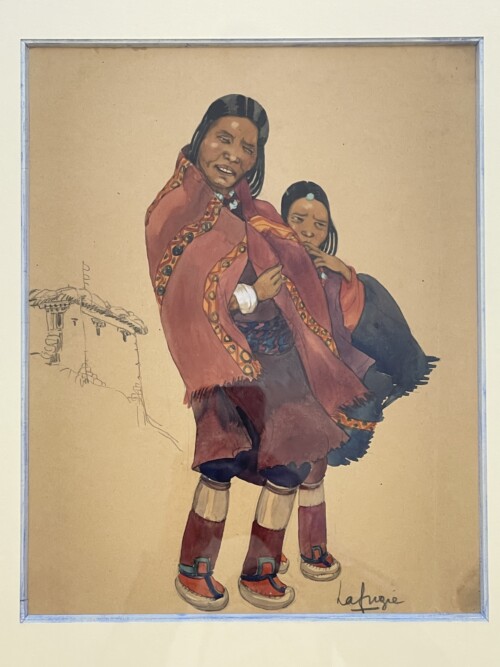
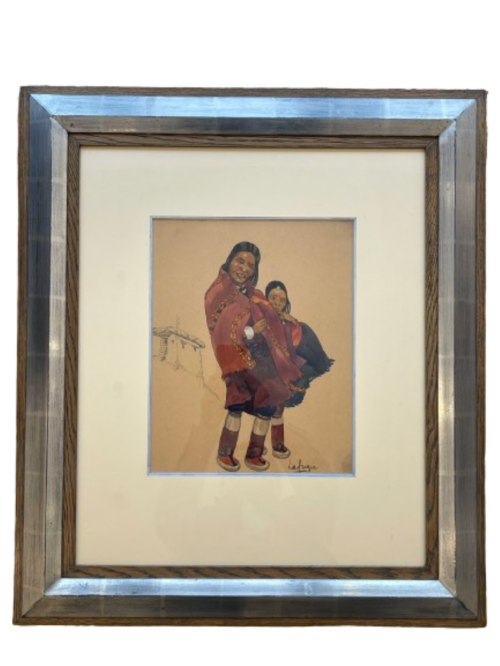 Léa LAFUGIE est une artiste peintre ayant voyagé à travers l’Asie, se faisant surtout connaître pour ses portraits ainsi que ses paysages qu’elle retranscrit dans ses peintures. Elle commence par étudier à l’École des Arts Décoratifs de Paris, puis à l’École des Beaux-Arts de Paris. Dotée d’une nature aventureuse et curieuse, c’est en 1925 que l’artiste décide de voyager en Asie, dont la Chine, l’Inde, le Japon et la péninsule indochinoise. Elle y peindra des paysages ainsi que des portraits lors de ses séjours. Cette gouache représentant une femme et un enfant tibétains, capture d’une expression faciale de méfiance et paradoxalement de réconfort marquée par ses couleurs et les tissus qui emmitouflent les tibétaines. La signature se trouve en bas vers la droite. Datation : entre 1925-1930, dates où Léa Lafugie s’est rendue en Asie. Dimensions : 32 x 25.5 cm Léa LAFUGIE is a painter who travelled throughout Asia, making herself known especially for her portraits and landscapes that she transcribes in her paintings. She began by studying at the School of Decorative Arts in Paris, then at the School of Fine Arts in Paris. Endowed with an adventurous and curious nature, it was in 1925 that the artist decided to travel to Asia, including China, India, Japan and the Indochinese peninsula. She painted landscapes and portraits during her stays. This gouache representing a Tibetan woman and child, captures a facial expression of mistrust and paradoxically comfort marked by its colors and fabrics that bundle Tibetans. The signature is on the bottom right. Dating: between 1925-1930, dates when Léa Lafugie went to Asia. Dimensions: 12.6 x 10.04 inches
Léa LAFUGIE est une artiste peintre ayant voyagé à travers l’Asie, se faisant surtout connaître pour ses portraits ainsi que ses paysages qu’elle retranscrit dans ses peintures. Elle commence par étudier à l’École des Arts Décoratifs de Paris, puis à l’École des Beaux-Arts de Paris. Dotée d’une nature aventureuse et curieuse, c’est en 1925 que l’artiste décide de voyager en Asie, dont la Chine, l’Inde, le Japon et la péninsule indochinoise. Elle y peindra des paysages ainsi que des portraits lors de ses séjours. Cette gouache représentant une femme et un enfant tibétains, capture d’une expression faciale de méfiance et paradoxalement de réconfort marquée par ses couleurs et les tissus qui emmitouflent les tibétaines. La signature se trouve en bas vers la droite. Datation : entre 1925-1930, dates où Léa Lafugie s’est rendue en Asie. Dimensions : 32 x 25.5 cm Léa LAFUGIE is a painter who travelled throughout Asia, making herself known especially for her portraits and landscapes that she transcribes in her paintings. She began by studying at the School of Decorative Arts in Paris, then at the School of Fine Arts in Paris. Endowed with an adventurous and curious nature, it was in 1925 that the artist decided to travel to Asia, including China, India, Japan and the Indochinese peninsula. She painted landscapes and portraits during her stays. This gouache representing a Tibetan woman and child, captures a facial expression of mistrust and paradoxically comfort marked by its colors and fabrics that bundle Tibetans. The signature is on the bottom right. Dating: between 1925-1930, dates when Léa Lafugie went to Asia. Dimensions: 12.6 x 10.04 inches -
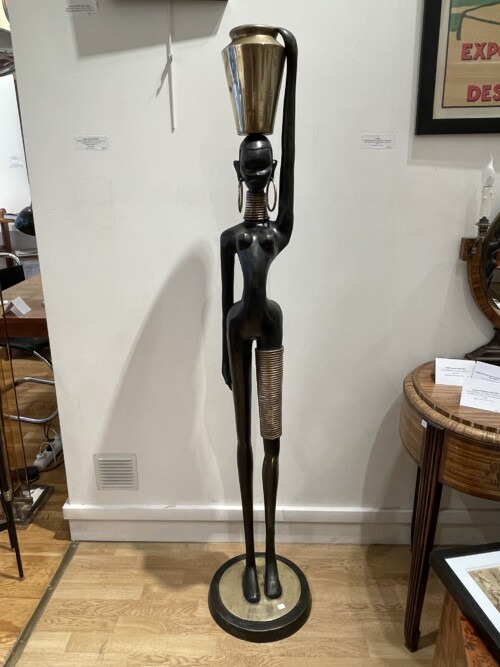
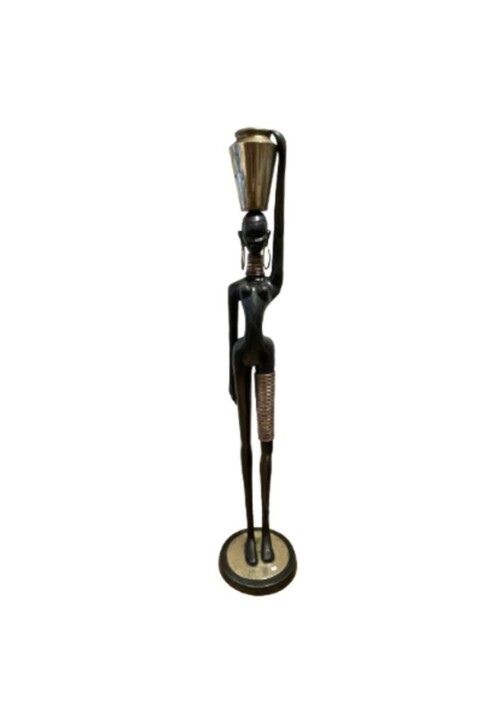 HAGENAUER (d’après), grande porteuse d’eau, « femme girafe » Bronze à double patine noire et dorée percée pour électrification, Années 1970 Dimensions : 163.5 cm Bronze grandeur nature d’une femme africaine portant de l’eau. La femme présente un corps stylisé aux proportions élancées dégangeant une grande élégance. Les membres sont allongés, le dos courbé pour laisser apparaître et mettre en valeur les attributs féminins. Un léger mouvement se dessine dans les jambes, évitant l’effet statique et animant la figure. Les traits du visage sont stylisés et simplifiés. Le corps est en bronze à patine noire, sombre, ce qui met en valeur la ligne et les courbes. Seuls les bijoux de cuisse, de cou, boucles d’oreilles et vase sont dorés ce qui relève les courbes et met en valeur le corps. Cette œuvre est caractéristique du style de Karl Hagenauer (1898-1956), un célèbre designer autrichien, spécialisé dans la production d’objets en métal et en bois, reconnu pour ses œuvres modernes et stylisées. Ce modèle date des années 1970, où de nombreuses rééditions des classiques de Hagenauer ont été réalisées. Nous présentons également dans notre galerie une paire de statuettes en bronze du même modèle mais en format plus réduit.
HAGENAUER (d’après), grande porteuse d’eau, « femme girafe » Bronze à double patine noire et dorée percée pour électrification, Années 1970 Dimensions : 163.5 cm Bronze grandeur nature d’une femme africaine portant de l’eau. La femme présente un corps stylisé aux proportions élancées dégangeant une grande élégance. Les membres sont allongés, le dos courbé pour laisser apparaître et mettre en valeur les attributs féminins. Un léger mouvement se dessine dans les jambes, évitant l’effet statique et animant la figure. Les traits du visage sont stylisés et simplifiés. Le corps est en bronze à patine noire, sombre, ce qui met en valeur la ligne et les courbes. Seuls les bijoux de cuisse, de cou, boucles d’oreilles et vase sont dorés ce qui relève les courbes et met en valeur le corps. Cette œuvre est caractéristique du style de Karl Hagenauer (1898-1956), un célèbre designer autrichien, spécialisé dans la production d’objets en métal et en bois, reconnu pour ses œuvres modernes et stylisées. Ce modèle date des années 1970, où de nombreuses rééditions des classiques de Hagenauer ont été réalisées. Nous présentons également dans notre galerie une paire de statuettes en bronze du même modèle mais en format plus réduit.
Stunning Bronze of an African lady carrying water, in the style of Karl Hagenauer (1898-1956), 1970’s, Bronze with double black and gilt patina, pierced for electrification Dimensions : 163.5 cm / 64,37 inches Stunning life-size bronze sculpture of an African woman carrying water. The woman's body is stylized with elegant elongated proportions. Her limbs are elongated, her back curved, emphasizing her feminine attributes. The legs are in motion, adding dynamism to the sculpture. Her facial features are simplified. The body is cast in black bronze, which enhances the curves and lines. Only the jewelry is gilded, further accentuating the body. This sculpture is in the typical style of Karl Hagenauer (1898-1956), a renowned Austrian designer specialized in wood and metalwork, famous for his stylized and modern figures. We also feature in our gallery a pair of smaller bronze statuettes of the same model. -
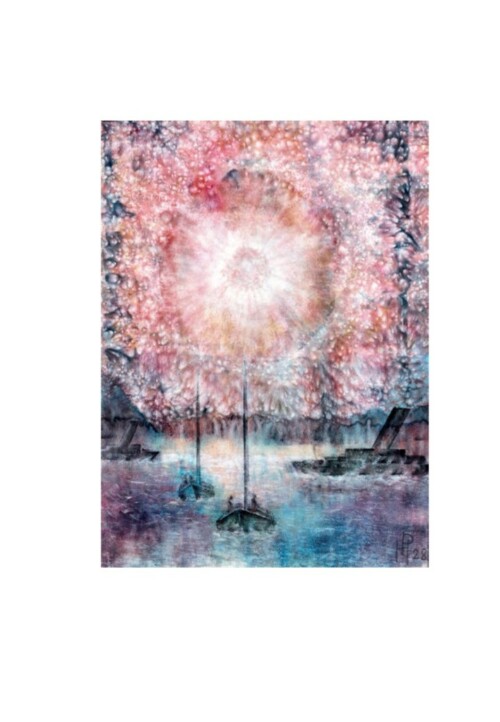 Henri PFEIFFER (1907-1994) Technique mixte représentant des navires de style cubiste, sous un feu d'artifice. Monogrammée "HP" et datée "28" Au revers inscription de la main de l'artiste : "Cette aquarelle signée HP28 est originale de mon époque Bauhaus". Signée Pfeiffer avec une autre inscription en bas à droite : " Ancien élève de Paul Klee". Dimensions : H : 46 cm ; L : 33,5 cm (sans cadre) H : 61 cm ; L : 49,3 cm (avec cadre) Pour plus d'informations sur le créateur, cliquer sur le nom : Henri PFEIFFER
Henri PFEIFFER (1907-1994) Technique mixte représentant des navires de style cubiste, sous un feu d'artifice. Monogrammée "HP" et datée "28" Au revers inscription de la main de l'artiste : "Cette aquarelle signée HP28 est originale de mon époque Bauhaus". Signée Pfeiffer avec une autre inscription en bas à droite : " Ancien élève de Paul Klee". Dimensions : H : 46 cm ; L : 33,5 cm (sans cadre) H : 61 cm ; L : 49,3 cm (avec cadre) Pour plus d'informations sur le créateur, cliquer sur le nom : Henri PFEIFFER
A Bauhaus painting by Henri Pfeiffer 1928.
Painting with cubist style by Henri Pfeiffer (1907-1994).
Monogrammed "HP" and dated "28"
On the reverse listing of the hand of the artist: "This watercolor signed HP28 is my original Bauhaus era." Signed Pfeiffer with another entry on the lower right: "A former student of Paul Klee".
Henri Pfeiffer joined the Bauhaus at the age of 17 where he became a student of Paul Klee. He created many abstract works with a renewed vision of the use and perception of colors. Very young, he studied intensively the chemistry of pigments with his uncle. In 1933 when the Bauhaus was forbidden he was arrested by the Gestapo but he succeed to be released with the help of his parents. He then abandonned painting but still got passionate with colors becoming a famous ophtalmologist specialized in the perception of colors. He wrote a book about the subject in the 1950’s. This early genius artist, who produced an avant-garde painting work with a fascinating research on colors, is a real discovery. His history and his journey from art to science with the continuous obsession of color perception understanding is fascinating and very consistent with the ethical and philosophical Bahaus principles which never separated art from science and industy.
Dimensions :H : 18.11 in. ; W : 13.2 in.H : 46 cm ; W : 33,5 cmFor more information : Henri PFEIFFER
-
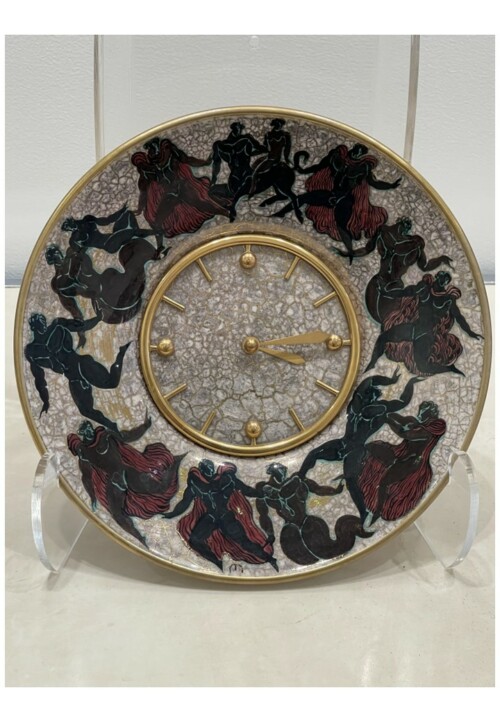
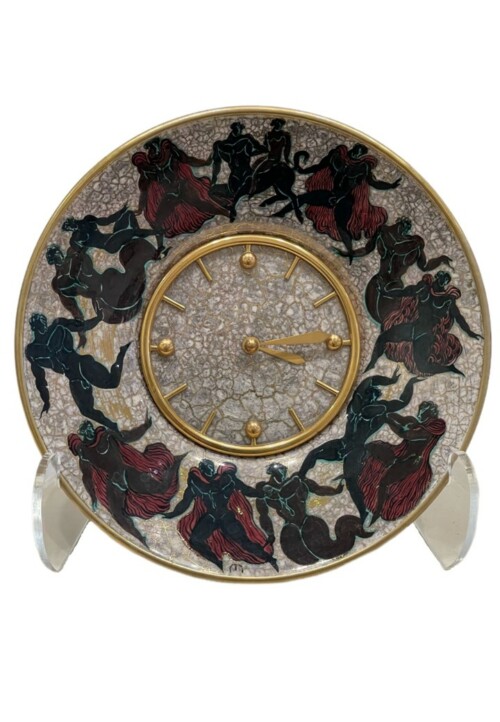 Superbe pendule par le célèbre horloger Hour Lavigne et le céramiste Jean Léon Mayodon (1893-1967). Objet composé d'une pendule en partie centrale Hour Lavigne montée sur un plat en céramique réalisé par Mayodon. La pendule a été conçue pour être montée sur un mur, elle peut aussi être utilisée comme pendule de table une fois posée sur un présentoir. Le décor représente une scène de danse de couples à l'Antique typique des années 1940 et 1950. Le décor est réalisé en émaux polychromes noir, rouge, vert, complété de rehauts d'or. Les aiguilles et le cadran sont en laiton doré. Le monogramme de Jean Léon Mayodon est présent en partie inférieure du décor et la signature d'Hour Lavigne est présente sur le mécanisme. Le mouvement de la pendule est mécanique (peut durer 7 jours) et est en état de fonctionnement. Jean Léon Mayodon a réalisé un modèle similaire pour le joaillier Cartier à New York dans les années 1950 où l'on peut retrouver un décor en émail et or de femmes nues dansantes. Hour Lavigne est un célèbre horloger renommé pour ses mouvements mécaniques hauts de gamme. Mayodon est un des plus célèbres céramistes français des années 1940, 1950 connu pour ses représentations néoclassiques. Diamètre : 26cm
Superbe pendule par le célèbre horloger Hour Lavigne et le céramiste Jean Léon Mayodon (1893-1967). Objet composé d'une pendule en partie centrale Hour Lavigne montée sur un plat en céramique réalisé par Mayodon. La pendule a été conçue pour être montée sur un mur, elle peut aussi être utilisée comme pendule de table une fois posée sur un présentoir. Le décor représente une scène de danse de couples à l'Antique typique des années 1940 et 1950. Le décor est réalisé en émaux polychromes noir, rouge, vert, complété de rehauts d'or. Les aiguilles et le cadran sont en laiton doré. Le monogramme de Jean Léon Mayodon est présent en partie inférieure du décor et la signature d'Hour Lavigne est présente sur le mécanisme. Le mouvement de la pendule est mécanique (peut durer 7 jours) et est en état de fonctionnement. Jean Léon Mayodon a réalisé un modèle similaire pour le joaillier Cartier à New York dans les années 1950 où l'on peut retrouver un décor en émail et or de femmes nues dansantes. Hour Lavigne est un célèbre horloger renommé pour ses mouvements mécaniques hauts de gamme. Mayodon est un des plus célèbres céramistes français des années 1940, 1950 connu pour ses représentations néoclassiques. Diamètre : 26cm
Stunning clock by famous clockmaker Hour Lavigne and ceramist Jean Léon Mayodon (1893-1967) This clock is made of a central clock by Hour Lavigne mounted on a plate realized by J.L. Mayodon. This clock is designed to be mounted on a wall but can also be used as a table clock if put on a stand. The decorative motif depicts an Antique-style scene of dansing couples typical from the 1940's 1950's. The decoration is executed in polychrome enamel, featuring black , green and red colours with gold accents. The hands and dial are made of gilded brass. The plate is signed by Jean Léon Mayodon's monogram located in the lower part. Hour Lavigne signature appears inside the clock mechanism. The clock movement is mechanical (around 7 days) and in working order. Hour Lavigne and Jean Léon Mayodon created a similar clock for Cartier in New York around 195o. Hour Lavigne is a famous clockmaker renowned for the quality of its high end mechanical movements. Mayodon is one of the most famous French ceramist in the 1940's 1950's with a neoclassical inspiration. Diameter : 10.24 inches/26 cm Depth : 2.37 inches / 6cm